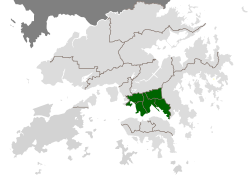Kowloon Peninsula 九龍半島 | |
|---|---|
 An aerial view of Kowloon Peninsula from Hong Kong Island in 2006 | |
 | |
| Coordinates: 22°19′N114°11′E / 22.31°N 114.18°E | |
| Time zone | UTC+8 (Hong Kong Time) |
| Kowloon Peninsula | |||||||||||||||||
|---|---|---|---|---|---|---|---|---|---|---|---|---|---|---|---|---|---|
| Traditional Chinese | 九龍半島 | ||||||||||||||||
| Simplified Chinese | 九龙半岛 | ||||||||||||||||
| |||||||||||||||||

The Kowloon Peninsula is a peninsula that is part of the southern part of the main landmass in the territory of Hong Kong,alongside Victoria Harbour and facing toward Hong Kong Island. The Kowloon Peninsula and Ngong Shuen Chau comprises the Old Kowloon. The Old Kowloon and the area of New Kowloon are collectively known as Kowloon.
Contents
Geographically,the term "Kowloon Peninsula" may also refer to the area south of the mountain ranges of Beacon Hill,Lion Rock,Tate's Cairn,Kowloon Peak,etc. The peninsula covers five of the eighteen districts of Hong Kong. Kowloon Bay is located at the northeast of the peninsula.



